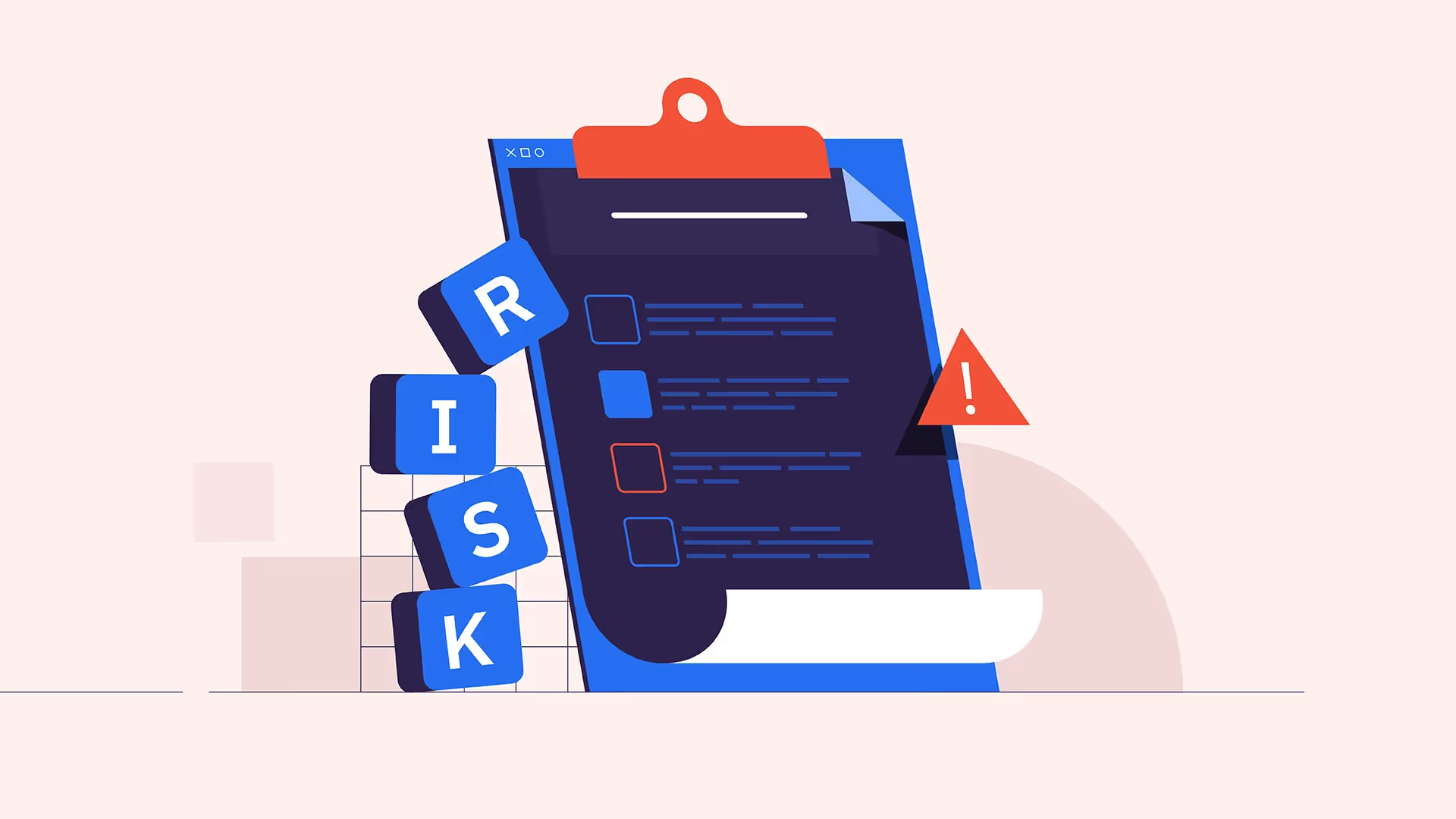We constantly face risks in our lives, and whether large or small, we have to make decisions about them daily. We may not even be aware of some of these risks.
However, there are some situations in which we need to know what kind of risk we will face so that we can take appropriate action. For instance, knowing the risks of a virus will enable us to take the necessary steps to prevent and mitigate its spread. Wouldn’t it be convenient to have a log of all these potential risks?
Now think of this in the context of a project. Every project has a certain degree of risk associated with it, which could impact its progress. However, maintaining a proper log of all potential risks after careful analysis can significantly enhance the project’s success. Let’s take a look at this in some more detail.
What is a Project Risk Register?
A Project Risk Register, also known as a project risk log, is a simple yet effective tool that identifies and describes all the potential risks that may impact a project. It is used to track and monitor project risks efficiently and is an important element of the overall project management framework. Additionally, it makes the project team aware of all potential risks and enables them to analyze and plan the appropriate course of action.
The Risk Register also includes other information such as the nature of the risk, the probability of its occurrence, etc. Thus, it is a critical step in the overall project risk management process.
Free Download: Project Risk Register Template
Why you need a Project Risk Register
Project risk can be defined as any event that can positively or negatively impact the progress of a project. Therefore, anything that could potentially affect your project must be assessed and recorded appropriately in the risk register. As a project grows, it becomes increasingly difficult to keep track of all its associated risks. The purpose of a project risk register is to identify, document, analyze and monitor these risks and provide a mitigation plan.
The Risk Register also includes other information such as the nature of the risk, its probability of occurrence, etc. Thus, it is a critical step in the overall project risk management process. Finally, listing all the potential risks and risk response plans in the register makes it a convenient reference point throughout the project.
Difference between Project Risk Registers and Risk Reports
It is easy to misunderstand a project risk register and a risk report. They may seem similar when you hear them for the first time. However, they are very different documents.
A project risk register is considered a master database of all the risks associated with a project. It will include all the details of the risks, including information to help mitigate them. It helps to identify and prioritize the critical and high-impact risks. Additionally, the risk register enables the project manager and the project team to manage risks down to a more acceptable level through regular reviews.
On the other hand, a project risk report is a high-level summary of the overall project risks, exposure, opportunities, and trends. It is a communication tool that is meant for a limited audience, primarily upper management. Therefore, the report must be created to effectively communicate the general risks and risk management of the project and its impact on the overall outcome.
When should you create a Project Risk Register?
A project risk register is generally created during the initial phase of a project. However, it is essential to note that risks change over time, and new ones may arise. Hence, it is necessary to review and update the risk register regularly.
Who creates the Project Risk Register?
For larger and more complex projects, the risk register is created and maintained by a designated risk manager or a risk coordinator. However, in most cases, the onus of making the risk register lies with the project manager.
While the project manager or the risk coordinator is responsible for creating and maintaining the project risk register, it is not their sole responsibility to identify, analyze and plan risks and risk responses. These activities are done by the entire project team as each team member could provide different contributions and perspectives.
How to create a Project Risk Register
Creating a project risk register is quite simple. It is a table with a column for each heading or element that you will be covering and a row for each identified risk. You can create the risk register using simple applications such as Microsoft Excel, Google Sheets, or any other similar application.
Alternatively, you could use an existing template for convenience. Here’s our free and completely customizable project risk register template.
The steps involved in creating a project risk register are:
1. Identifying risks
The first step is to get the project team together and brainstorm all possible risks. Each team member will have a unique contribution in identifying and dealing with different risks based on their area of expertise. This is also a good time to talk to the project sponsor and other stakeholders to ensure that their risks are also being taken into account. Sometimes, based on experience from similar projects in the past, you might have to look into historical data to identify recurring patterns. This will ensure that you are thorough with identifying all potential risks, including risks associated with weather, resources, etc.
2. Describing the risks
The next step is to describe each risk clearly and concisely. Avoid being too vague as it will be challenging for the team to understand the risk and its implications when it becomes a real issue. At the same time, make sure that you don’t go into too much detail unnecessarily. For instance, if the weather is a potential risk in your project, don’t just say “weather”. Instead, try to describe it a little more. For example, you could say ‘Snowfall during winter in Seattle can cause delays in the shipping of raw materials’.
3. Analyzing risk impact
Take into consideration everything that the risk can affect in your project. This will help you rank the impact appropriately and develop an efficient strategy to deal with the risk. Usually, the impact is ranked on a 3-5 point scale or from high to low. However, you could also include a column that describes the impact in a concise manner. E.g. if you’ve been hearing about resource issues or attritions that could delay your production schedule for the manufacturing company you’re working with, call it out as a risk and consider all of its implications before rating it. This will also enable the project team and the responsible member to develop a response plan or strategy if this risk turns into an actual issue.
4. Planning risk response
This is a critical step in building your project risk register. Spend enough time and effort in ensuring that you’re thorough with planning your responses. Keep it detailed and concise so that you can directly work on executing the response plan in case the risk turns into an issue. If you feel like your response plans plan needs to be more detailed and should include more information, you can include links to additional documents and resources when required.
5. Prioritizing and ranking the risks
All risks are not the same. Some are more important and critical than others. Based on the probability and impact of a given risk, it can be ranked numerically or from high to low. This will enable you to filter and prioritize the risks that need to be addressed first.
6. Assigning an owner to the risks
Finally, assign each risk to an owner within the team. This person will be responsible for managing and monitoring the assigned risk.
Components of a Project Risk Register
A risk register typically consists of the following components.
- Risk ID: This is a unique number that is assigned to each risk for easy identification.
- Name or Description: As the name suggests, this is where you should mention the name of the risk or provide a brief description of it.
- Risk Category: This refers to the type of risk. Risks can be primarily classified as internal or external, and they must be mentioned under the risk category. You could include other categories such as “labor-related” or “material-related” to make categorization more specific. They can be customized to fit your project. This can help you filter risks based on the category, which makes it easier to monitor and analyze.
- Likelihood of Occurrence: This refers to the probability of the risk occurring. How likely is it to happen? You could rank them as high, medium, or low. This can also be ranked numerically on a 3-5 point scale.
- Risk Impact: This refers to the level of impact that the risk is likely to have on the project’s progress if it does occur. This could also be categorized as high, medium, or low. This can also be ranked numerically on a 3-5 point scale.
- Risk Rating: The risk is ranked based on its probability and impact.
- Risk Owner: You must mention the team member who is responsible for managing the risk or mitigating it here.
- Approach: This refers to how you plan on managing a given risk. Do you plan to monitor it, mitigate it, or avoid it? Whatever is decided must be mentioned here.
- Mitigation Plan: This refers to how you plan on mitigating or avoiding the risk if it does occur. Describe your plan here.
- Status: This refers to the current status of the risk if it does occur. Whether it is mitigated or active, it must be mentioned here. This will give the team an idea about the status of different risks throughout the project.
- Comments: Any additional comments or information related to the risk can be included here.
Here is a filled up project risk register example for your reference:

Free Download: Project Risk Register Template
How to assess risk
Proper analysis of risk is essential for project success. Risk can be assessed using two main methods- Quantitative and Qualitative analysis.
1. Qualitative analysis
Qualitative analysis is subjective. It is the easiest and most common method of risk analysis, which focuses on measuring the likelihood or probability of a risk event occurring and the impact it is likely to have if it does occur. Measurement is done using a 3-5 point scale ranging from very low and low to medium, high, and very high. This measurement is then used to determine the severity of the risk, which is recorded in the risk register.
2. Quantitative analysis
Quantitative analysis is objective and makes use of quantifiable and measurable data to assess the risk. The effect of the risk is analyzed for schedule delays, resource consumption, and costs. Then, a numerical value is assigned to the extent of the risk based on the available data. Let us consider the example of high attritions in a related manufacturing company causing schedule delays that we discussed previously. Let us say that this risk has a 30% chance of occurring based on verifiable data and a 10% chance of causing a delay of 5 days. Although this is more complex, it provides a rather accurate analysis of the risk. But this accuracy is entirely dependent on the quantity and accuracy of the data being used.
Choose the method the works best for you and your project. Then, whichever method you finally decide to use, ensure that it is consistent throughout the register and your project.
Common mistakes to avoid
A project risk register can be a handy tool to project managers when made and used efficiently. However, only a tiny percentage of organizations think it is effective. To make the best use of your project risk register, make sure to avoid these common mistakes.
1. Not updating the project risk register at regular intervals
The project risk register is made during the initial stage of a project and is reviewed regularly. However, just reviewing the existing risks over and over is not enough. As the project grows and evolves, so do the risks associated with it. As a result, new risks may appear, and existing ones may change or become obsolete. Hence, it is essential to update the risk register regularly. It becomes ineffective and inefficient if it is not updated.
2. Making the risk register too complex
Ensure that you make your risk register simple to review, simple to update, and simple to understand. A complex and overly detailed risk register with too many columns, scales, and color codes can make it difficult to understand and update regularly. Hence, it is best to keep it simple and concisely provide all the necessary information.
3. Not taking the document seriously
There are times when the document is not taken seriously enough. It is just considered to be another document to cross off the checklist. This ultimately leads to its poor maintenance. Thereby making it inefficient.
Project Risk Register Template
In conclusion, a project risk register is an integral tool in the overall project risk management process, and it plays a very important role in determining the success or failure of the project.
You could download this free template and customize it according to your requirements.
Good luck!

























.webp)